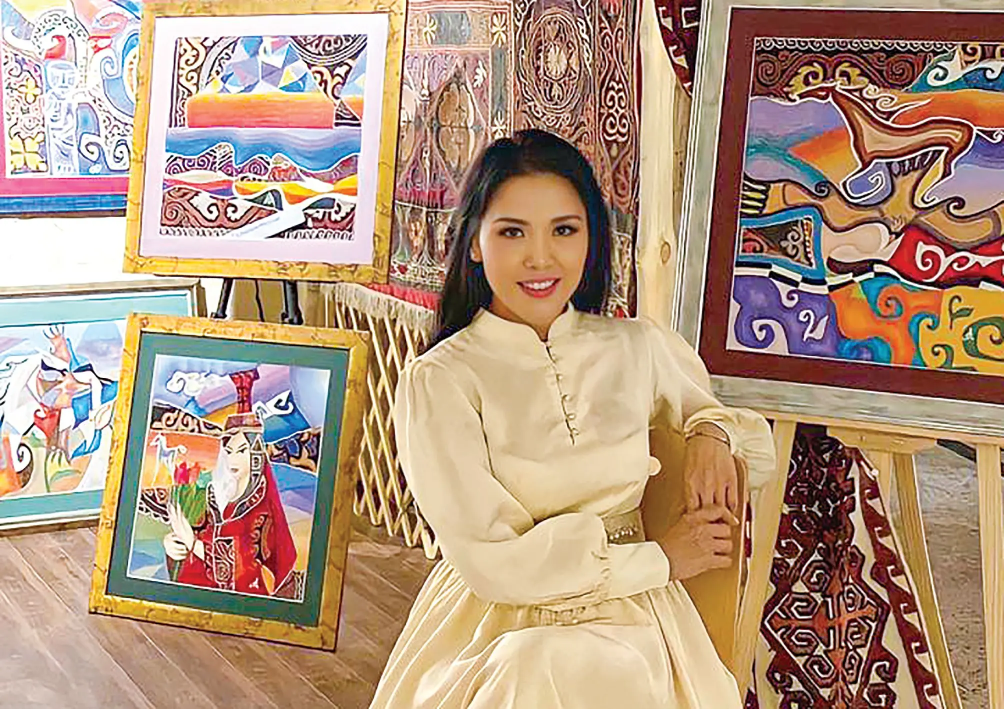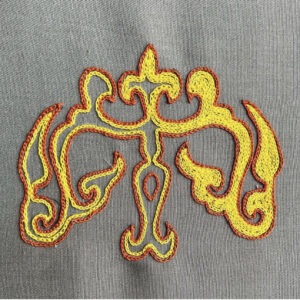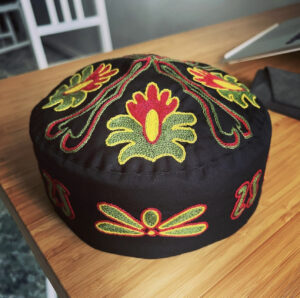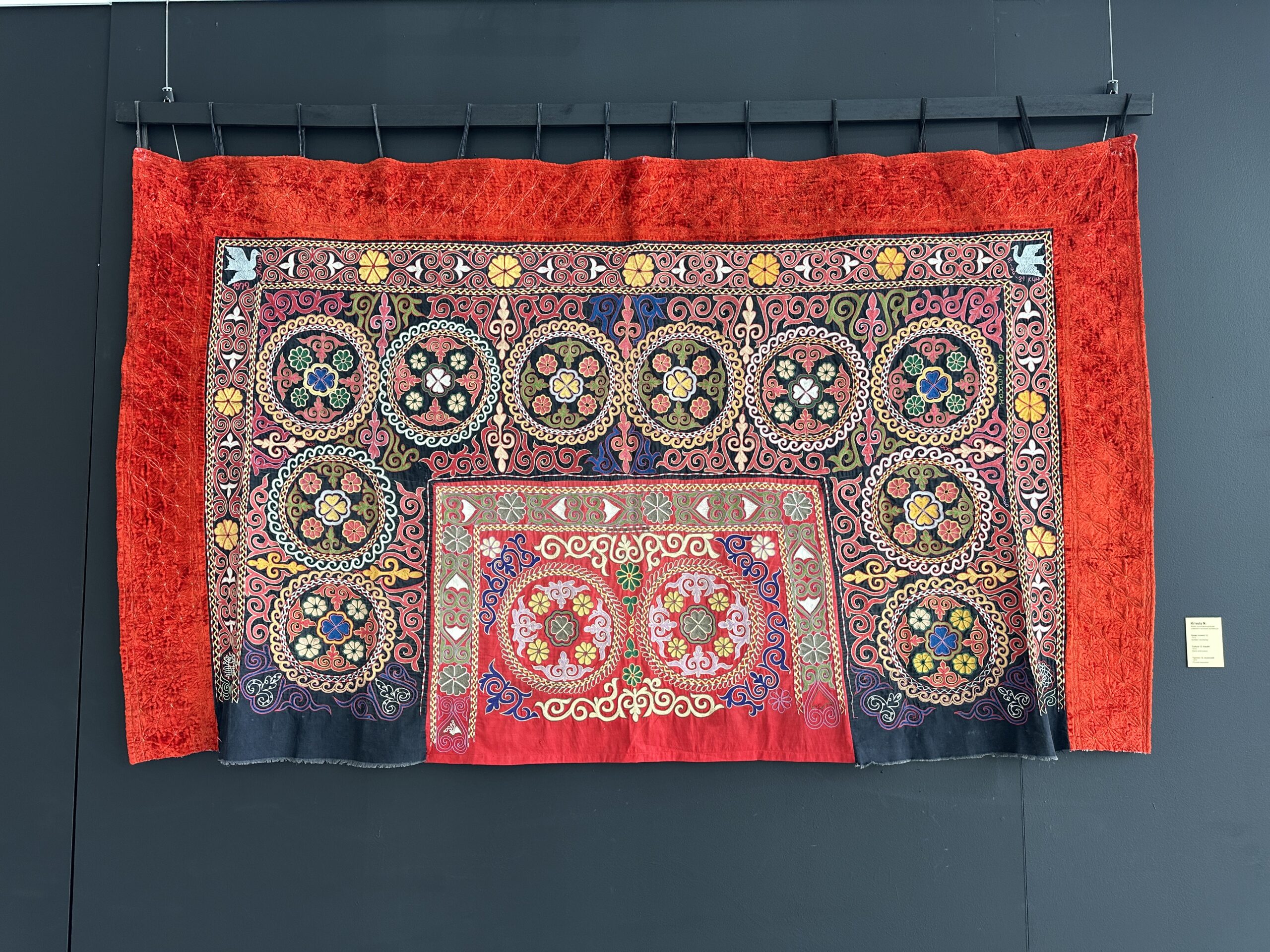ASTANA – Young artists, both professional and amateur, are reviving the ancient art of Kazakh embroidery, biz keste, by showcasing the appeal and value of this intricate craft in their works.

Young Kazakh biz keste artist, Gulnazym Omirzak, demonstrates through her work that embroidery is not a mere craft but rather a sophisticated art form. Photo credit: elorda.info
Biz keste, translated as a chart made with a hook, is a traditional embroidery with colorful threads and one of the lasting representations of the region’s identity and rich culture. It is a timeless craft that has not changed much from its original form over millennia.
Young biz keste artists
Biz keste embroidery is increasingly being employed as an art form rather than merely women’s work. Young Kazakh biz keste artist, Gulnazym Omirzak, demonstrates through her work that embroidery is not a mere craft but rather a sophisticated form of art.
A series of her embroidery on canvas reflect the power of national identity. According to her, the traditional Kazakh embroidery technology can become a national brand of the country. In her canvases, the images of Kazakh women sit alongside finely detailed abstract forms.
“This is an art we inherited from our grandmothers. By embracing and taking over this heritage, we both revive and modernize it, interspersing our own new elements. And this attracts foreign craftspeople, who are keen to learn our art. There are even those who are already doing it, even though they haven’t fully learned it yet, but they are really interested,” said Omirzak in an interview with Jibek Joly TV channel.
Biz keste revival
A decade ago, many predicted the decline of biz keste craft skills. However, there is now a renewed hope for its resurgence as young Kazakhs are drawing from centuries-old methods to enrich their modern designs in clothing and household items.

Bolat Nassygazy is one the amateur embroiderers who pursue a larger goal of reviving and embracing textile crafts. Photo credit: Instagram @nassygazy
Bolat Nassygazy is one the amateur embroiderers who pursue a larger goal of reviving and embracing textile crafts, including biz keste.
“One of the reasons I decided to try to start learning biz keste was my search for creativity,” he said in an interview with The Astana Times.
“In my school years, I was thinking of becoming a fashion designer, but I ultimately chose a different career path. But my desire to do creative work never left me, so within the last three or four years, I started thinking about how I can explore my creative side,” he said.
Nassygazy’s journey into learning the biz keste technique might not have materialized if it weren’t for his grandfather’s taqiya, a traditional Kazakh headwear.
“I remembered that actually my grandfather’s headwear was made with this technique and I found it to be so beautiful,” he said.

Work in progress. Photo credit: Instagram @nassygazy_art
Noticing the aging signs and wear on the headwear, Nassygazy decided to recreate one himself.
“I thought that maybe it would be great to renew the taqiya by making a new one. So that’s how I started searching for a craftsman who can teach me how to embroider using the biz keste technique,” he said.
The renaissance of biz keste could also be fuelled by an appreciation of traditional craftsmanship reaching younger, more design-conscious artists and their wish to pay homage to traditional craftsmanship.
“I guess one of the reasons for biz keste was my talk with Aizhan Bekkulova [the Chairwoman of the Union of Artisans of Kazakhstan] as she mentioned that we are losing this knowledge of our ancestors. The younger generation is no longer interested in learning knitting techniques and traditional craftsmanship. So, I wanted to rejuvenate it and pass on this knowledge to the younger generation and perhaps even make it more fashionable and modern,” said Nassygazy.
Biz keste embroidery is also evolving from being just a garnishing or ornamental piece to becoming an integral part of the design that could convey a message. This is also what Nassygazy hopes to impart in his embroidery.

Taqiya embroidered by biz keste technique. Photo credit: Instagram @nassygazy_art
“To make sure I don’t forget this technique, I started making an embroidery of the sentence ‘Menimen Kazaksha soile!’ (Speak Kazakh to me) on my tote bag in a message that ‘I can speak Kazakh and please speak to me in Kazakh.’ I also tried to upcycle one of my long sleeves so I made the yurt embroidery on the logo, so it would look like something new. This led to two additional orders for similar designs on t-shirts,” he said.
Nassygazy’s next goal is to design a collection of taqiya, something that might turn heads and represent the unique style of the one who wears it.
“I would like to make a collection of taqiya with more vivid colors than we usually use, especially for men. It was always a challenge for me to find a beautiful taqiya. And it’s always almost impossible to find really good quality taqiya. I want to create such items so that people can really feel the quality and it would be the kind of a masterpiece they would wear with pride,” he said.
Embroidered carpet – tuskiiz
The age-old biz keste craft may seem like a simple case of taking a needle and thread to cloth, but when it comes to creating wall hangings, called tuskiiz, it demands many hours of work and sheer precision.

Hand-made tuskiiz carpet embroidered by biz keste method. Photo credit: The Astana Times.
Embroidering a carpet is a centuries-old aesthetic tradition of nomadic people. It is a slow process that involves months and sometimes years of work. This is the real beauty of such work.
A hand-embroidered carpet tells a story of the love of that particular embroiderer with each stitch that is created. The details on the carpet may contain the name of the woman knitting and the name of the recipient, usually a daughter.
“Crafting such a carpet can genuinely span an entire year. It is not an exaggeration. I asked very experienced biz keste artisans, and they confirmed that it can take from six months to one year to complete a medium-sized carpet,” said Nassygazy.

